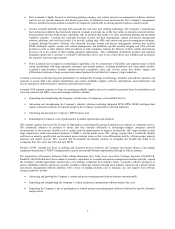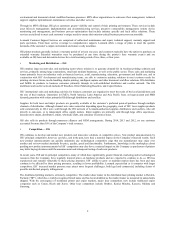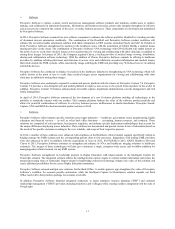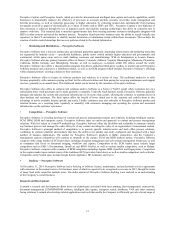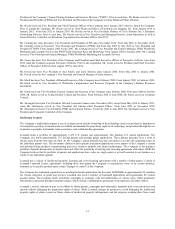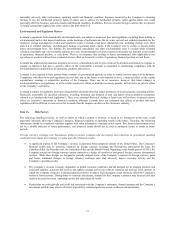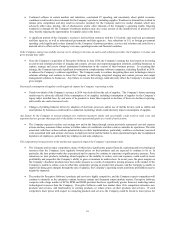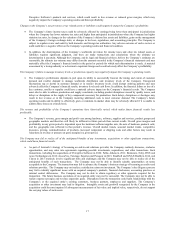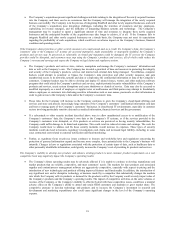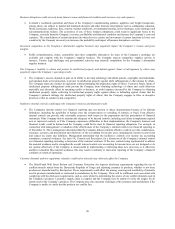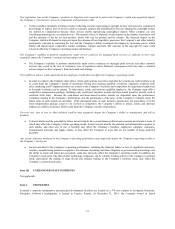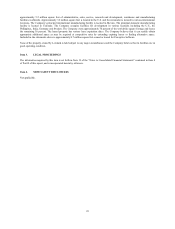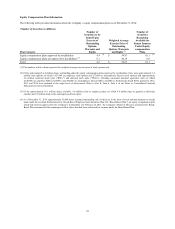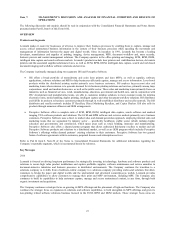Lexmark 2014 Annual Report Download - page 21
Download and view the complete annual report
Please find page 21 of the 2014 Lexmark annual report below. You can navigate through the pages in the report by either clicking on the pages listed below, or by using the keyword search tool below to find specific information within the annual report.Perceptive Software’s products and services, which could result in less revenue or reduced gross margins, which may
negatively impact the Company’s operating results and future profitability.
Changes in the Company’s tax provisions or tax related assets or liabilities could negatively impact the Company’s profitability.
The Company’s future income taxes could be adversely affected by earnings being lower than anticipated in jurisdictions
where the Company has lower statutory tax rates and higher than anticipated in jurisdictions where the Company has higher
statutory tax rates, by changes in the valuation of the Company’s deferred tax assets and liabilities, gains on the management
of the Company’s foreign exchange risks, or changes in tax laws, regulations, and accounting principles. The Company is
subject to regular review and audit by both domestic and foreign tax authorities. Any adverse outcome of such a review or
audit could have a negative effect on the Company’s operating results and financial condition.
In addition, the determination of the Company’s worldwide provision for income taxes and other tax related assets or
liabilities requires significant judgment, and there are many transactions and calculations where the ultimate tax
determination is uncertain. Although the Company, and its legal and financial advisors, believe the Company’s estimates are
reasonable, the ultimate tax outcome may differ from the amounts recorded in the Company’s financial statements and may
materially affect the Company’s financial results in the period or periods for which such determination is made. A material
assessment by a taxing authority or a decision to repatriate foreign cash could adversely affect the Company’s profitability.
The Company’s failure to manage inventory levels or production capacity may negatively impact the Company’s operating results.
The Company’s performance depends in part upon its ability to successfully forecast the timing and extent of customer
demand and reseller demand to manage worldwide distribution and inventory levels of the Company. Unexpected
fluctuations (up or down) in customer demand or in reseller inventory levels could disrupt ordering patterns and may
adversely affect the Company’s financial results, inventory levels and cash flows. In addition, the financial failure or loss of a
key customer, reseller or supplier could have a material adverse impact on the Company’s financial results. The Company
must also be able to address production and supply constraints, including product disruptions caused by quality issues, and
delays or disruptions in the supply of key components necessary for production. Such delays, disruptions or shortages may
result in lost revenue or in the Company incurring additional costs to meet customer demand. The Company’s future
operating results and its ability to effectively grow or maintain its market share may be adversely affected if it is unable to
address these issues on a timely basis.
The revenue and profitability of the Company’s operations have historically varied, which makes future financial results less
predictable.
The Company’s revenue, gross margin and profit vary among hardware, software, supplies and services, product groups and
geographic markets and therefore will likely be different in future periods than current results. Overall gross margins and
profitability in any given period is dependent upon the hardware/software/supplies mix, the mix of hardware products sold,
and the geographic mix reflected in that period’s revenue. Overall market trends, seasonal market trends, competitive
pressures, pricing, commoditization of products, increased component or shipping costs and other factors may result in
reductions in revenue or pressure on gross margins in a given period.
The Company may fail to realize all of the anticipated benefits of any investments, acquisitions or other significant transactions,
which could harm financial results.
As part of Lexmark’s strategy of becoming an end-to-end solutions provider, the Company routinely discusses, evaluates
opportunities, and may enter into agreements regarding possible investments, acquisitions, and other transactions. Such
transactions, including the acquisitions of Perceptive Software in 2010; Pallas Athena in 2011; Brainware, Nolij, ISYS and
Acuo Technologies in 2012; AccessVia, Twistage, Saperion and Pacsgear in 2013; ReadSoft and GNAX Health in 2014, and
Claron in 2015 routinely involve significant risks and challenges and the Company may not be able to realize all of the
anticipated benefits of such transactions. The Company may not be able to identify suitable opportunities on terms
acceptable to the Company. The transaction may fail to advance the Company’s business strategy of becoming an end-to-end
solutions provider. The Company may not realize a satisfactory return on investment. The Company’s due diligence process
may fail to identify significant issues with an acquired company’s products, financial disclosures, accounting practices or
internal control deficiencies. The Company may not be able to obtain regulatory or other approvals required for the
transaction. The future business operations of an acquired entity may not be successful. The Company may not be able to
realize expense synergies and revenue expansion goals. Disruptions from the transaction could harm relationships with the
Company’s or the acquired entity’s existing customers, business partners, employees and suppliers. The Company’s
acquisition or other investment may lead to litigation. Intangible assets and goodwill recognized by the Company in the
acquisition could become impaired if subsequent measurements of fair value and implied value, respectively, do not support
the carrying values of such assets.
17


